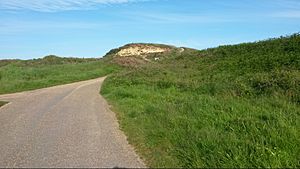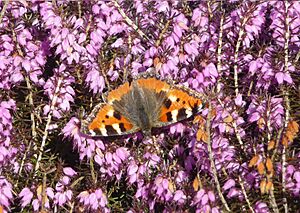Warren Hill, Bournemouth facts for kids
 |
|
| Location | Near Christchurch |
|---|---|
| Region | Dorset, England |
| Coordinates | 50°42′53.17″N 1°45′17.68″W / 50.7147694°N 1.7549111°W |
| Type | SSSI, Ancient Monument, Local Nature Reserve |
| History | |
| Periods | Stone Age, Bronze Age and Iron Age |
| Site notes | |
| Condition | Well preserved |
Warren Hill is a special high area in Dorset, England. It is part of Hengistbury Head. From Warren Hill, you can look out over Christchurch to the north and Poole Bay to the west.
This place is very important for its history, going back over 10,000 years! It is protected as an Ancient Monument and a Local Nature Reserve. The whole area, including Warren Hill, is also a Site of Special Scientific Interest. You can find tough heather plants growing on the flat top of the hill. It's a great place for walks all year round, offering amazing views and a unique heathland environment to explore.
Contents
Exploring Warren Hill's Past
Warren Hill is a very important place for understanding human history. People have visited and lived here for a very long time. This goes all the way back to the Paleolithic period, which was the Old Stone Age. Today, over a million people visit Hengistbury Head every year.
Warren Hill has many old remains and features. These date from about 10,000 BC up to Roman times. The hill's high position gives great views of the area. This, along with different natural places nearby, made it a good spot for people in ancient times and today.
Ancient Tools and Discoveries
In 1913, farmers plowing Warren Hill found thousands of flint tools. These tools showed that people lived here throughout the entire Stone Age. Some special blades were found that are usually seen in caves in Europe. Finding them in an open-air spot in the UK is very rare.
Later digs found over 600 more tools. Many of these were "backed blades," which are sharp tools with one dull edge for holding. There were also "endscrapers" for cleaning animal hides and "burins" for carving.
Old Mounds and Trenches
You can also see several large earth mounds on the hill. These are called barrow mounds. They were built a long time ago, often as burial places. People have studied them before to learn more about the past.
There are also small trenches from the Second World War. These were built for defense. Over many years, parts of Hengistbury Head have been lost. This is due to the sea, weather, and people taking away large ironstone rocks. This loss has meant some ancient sites, like old iron-making hearths and a Mesolithic (Middle Stone Age) camp, have disappeared.
Plants and Animals of Warren Hill
Warren Hill is a vital heathland home for many plants and animals. This type of habitat is very important and is part of a plan to protect nature in the UK. The hill is right next to Withybed Wood, which is another important natural area. Many birds use it as a stop during their long journeys.
Hengistbury Head became a Local Nature Reserve in 1990. The heathland here is so special that it is also a Special Area of Conservation and a Special Protection Area. These are part of a network of the best wildlife sites in Europe.
Plants on the Plateau
The top of Warren Hill is mostly covered by a plant called ling, which is also known as common heather. In drier spots, you can find heather-bell. In wetter areas, another type of heather called cross-leaved heath grows.
Small gorse bushes and tormentil plants add bright colors to the area. If you look closely in the boggy parts, you might see sundews. These are amazing carnivorous plants that catch and eat insects to get extra food!
Wildlife of the Hill

Many birds live and thrive on Warren Hill. You can often see meadow pipits and skylarks flying above. There are usually about five pairs of skylarks and nine pairs of meadow pipits nesting here. Three pairs of Dartford warblers also make their homes on the hill.
At night, you might find the violet ground beetle. During the day, the fast and powerful green tiger beetle hunts for food. These beetles, along with spiders, provide a regular meal for the birds that visit Warren Hill.
Exposed sandy areas attract special insects. You might see sand wasps digging their burrows. Other interesting insects include the rare nomad bee, the large velvet ant, and the cuckoo bee. On the hill, you can also find populations of the adder snake and the common lizard.

